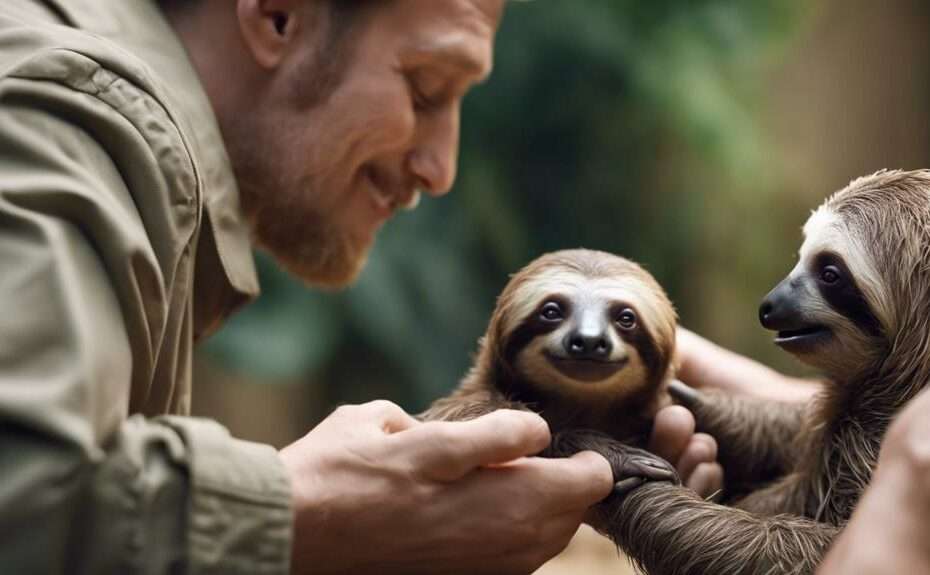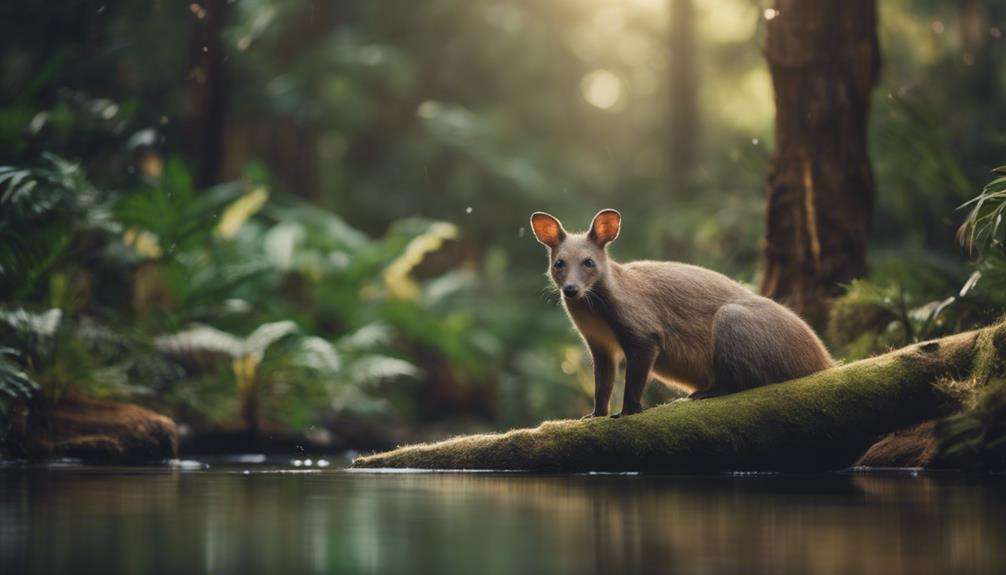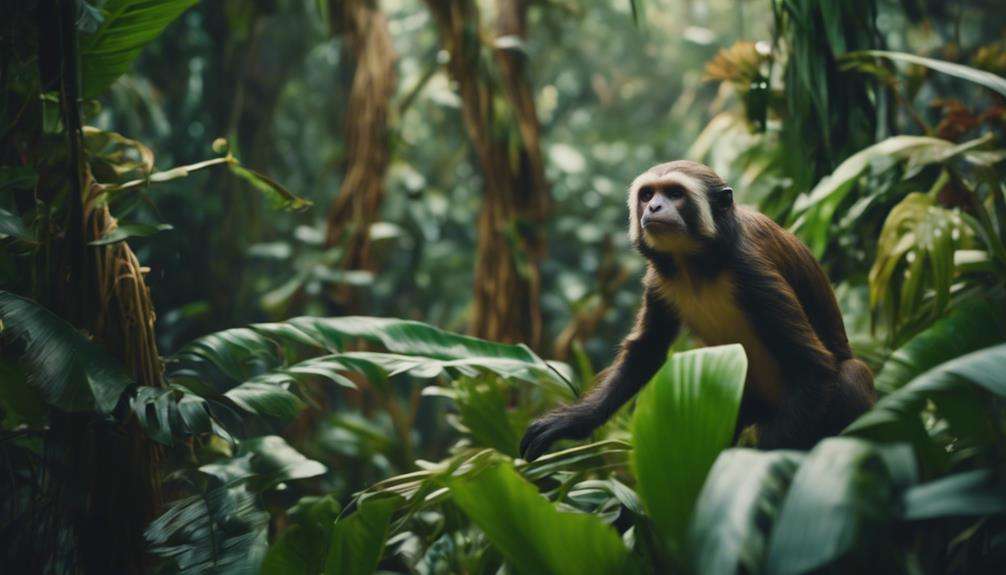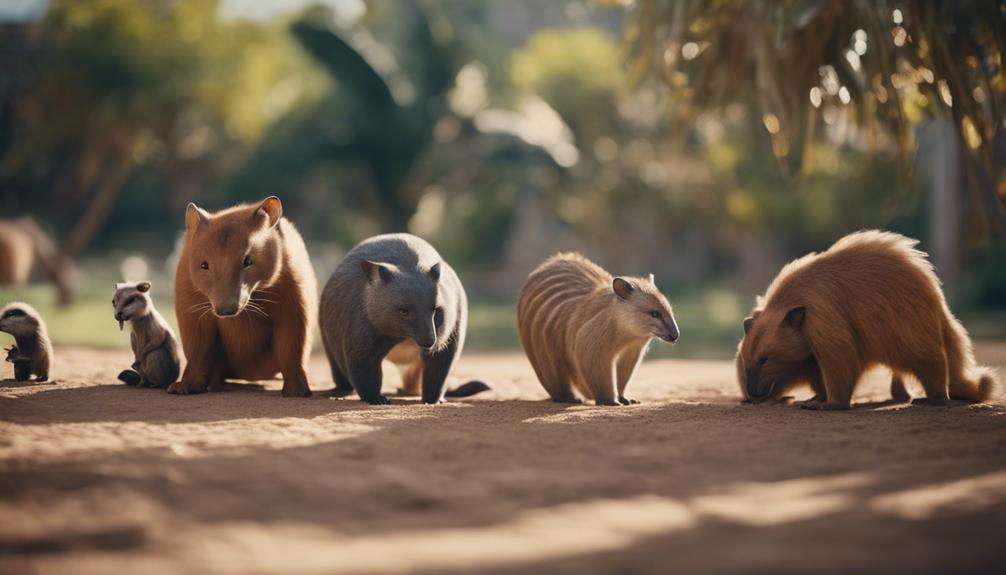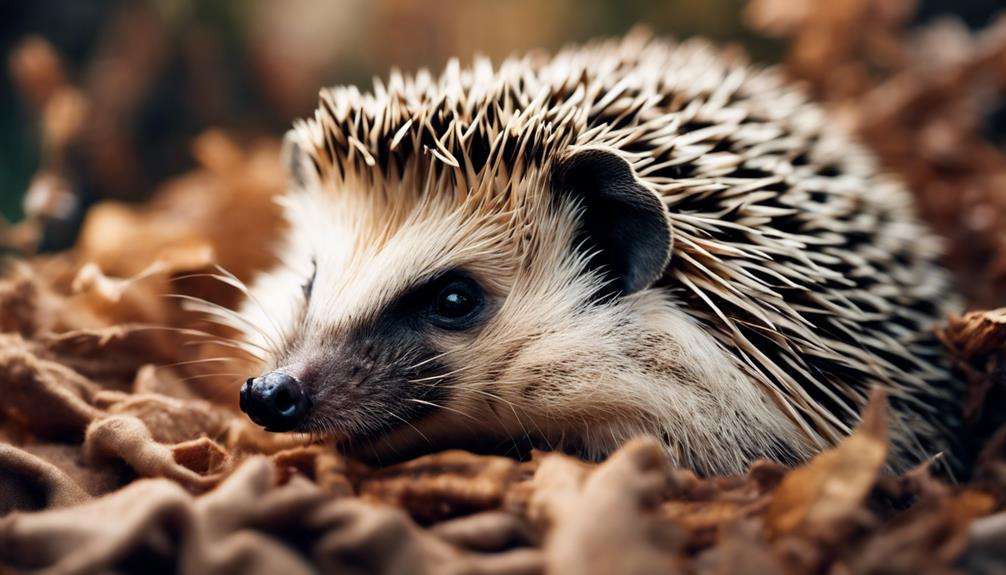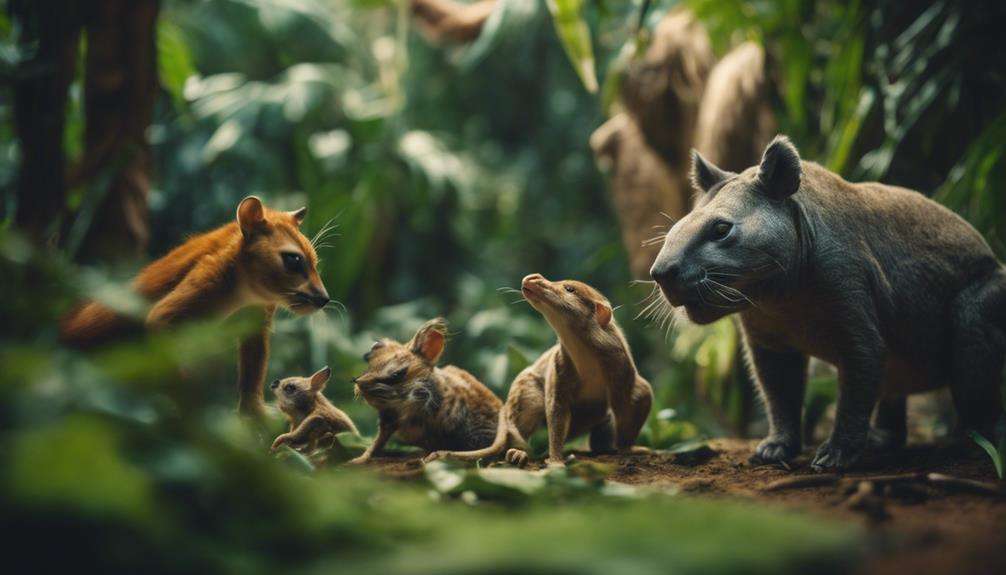When it comes to bonding with exotic mammals, remember: 'Patience is a virtue.'
Discovering the intricacies of these unique creatures can be a rewarding journey that requires dedication and understanding.
As you navigate the realm of rare bonding techniques, you'll uncover valuable insights that can transform your relationship with your exotic pet.
By implementing specialized tips and techniques, you can pave the way for a deep and meaningful connection that transcends the ordinary.
Explore the possibilities and unlock the secrets to fostering a bond like no other.
Key Takeaways
- Create a calm environment and bond through positive reinforcement techniques.
- Engage in daily quality time and provide physical contact opportunities.
- Respect individual preferences and boundaries for effective bonding.
- Utilize communication and enrichment activities to enhance mental and physical well-being.
Setting the Stage for Bonding
To begin fostering a strong bond with exotic mammals, create a quiet and safe environment that promotes feelings of security and comfort. This environment should be free from loud noises and sudden movements that could startle or stress your exotic mammal. Utilize positive reinforcement techniques like treats and praise to build trust and strengthen the bond between you and your furry friend. Exotic mammals respond well to rewards and will quickly learn to associate your presence with positive experiences.
Spending quality time with your exotic mammal daily is essential in establishing a routine and enhancing the bonding process. Provide opportunities for physical contact and grooming, mimicking social behaviors seen in the wild. By respecting the individual preferences and boundaries of your exotic mammal, you can avoid causing stress or fear, which may hinder the bonding process. Remember, patience is key when building a bond with exotic mammals.
Understanding Species-Specific Communication
Exotic mammals communicate through a variety of methods, including body language, vocalizations, and scent marking. Each species has its own unique ways of expressing emotions and intentions, such as tail flicking, ear positioning, chirps, squeaks, or purring.
Understanding these species-specific communication cues is crucial for interpreting their needs and forging a strong bond based on mutual understanding.
Vocalizations in Mammals
Different mammal species exhibit a diverse range of vocalizations, each serving a specific function in their communication repertoire. From calls to grunts, squeaks, and chirps, these vocalizations play a crucial role in conveying messages such as warning signals, mating calls, distress calls, and territorial announcements.
Exotic pets often possess unique vocal repertoires, allowing for intricate social interactions within their species. By paying attention to these vocalizations, you can gain valuable insights into your exotic pet's emotions and needs, thus strengthening the bond between you. Understanding the context and tone of these vocal cues is essential for interpreting your pet's communication effectively.
Body Language Cues
When observing exotic mammals, pay close attention to their species-specific body language cues, including ear position, tail movement, and facial expressions, as these signals convey valuable insights into their emotions and intentions. For exotic mammals, body language is a key component of their communication repertoire.
Raised fur or bristling may indicate fear or aggression, while a relaxed body posture signifies comfort and trust. By understanding and responding to these non-verbal cues, you can strengthen the bond with your exotic mammal. Respect for their communication style fosters mutual understanding and builds trust, leading to a harmonious relationship.
Take the time to observe and interpret these subtle signals to enhance your communication and connection with exotic mammals.
Scent Communication
Observing exotic mammals closely reveals how scent plays a significant role in their species-specific communication patterns, conveying essential information about identity, reproductive status, and social hierarchies.
Exotic mammals utilize scent to mark territory, establish familiarity, and communicate emotional states within their social groups. Species-specific scent markings are crucial for social interactions and hierarchies, allowing individuals to recognize each other and maintain group cohesion.
Specialized scent glands in exotic mammals secrete pheromones that play a vital role in signaling reproductive readiness and maintaining social bonds. Understanding the nuances of scent communication is key to interpreting social behaviors and developing strong bonds with exotic mammals.
Utilizing Enrichment Activities for Engagement
Enrichment activities play a crucial role in engaging exotic mammals both mentally and physically, enhancing their overall well-being and cognitive function. When it comes to training for exotic mammals, incorporating a variety of enrichment activities can significantly impact their engagement levels.
- Stimulating Variety: Offering puzzle feeders, foraging toys, and climbing structures provides exotic mammals with diverse ways to engage their minds and bodies, preventing monotony and promoting curiosity.
- Natural Simulation: Tailoring enrichment activities to mimic the natural behaviors of exotic mammals in the wild not only keeps them mentally stimulated but also nurtures their cognitive abilities and emotional well-being.
- Rotational Strategy: Regularly rotating enrichment items is essential to avoid habituation, ensuring sustained interest and active participation from exotic mammals, promoting exploration, problem-solving skills, and physical exercise for their overall health and happiness.
Creating a Safe and Secure Environment
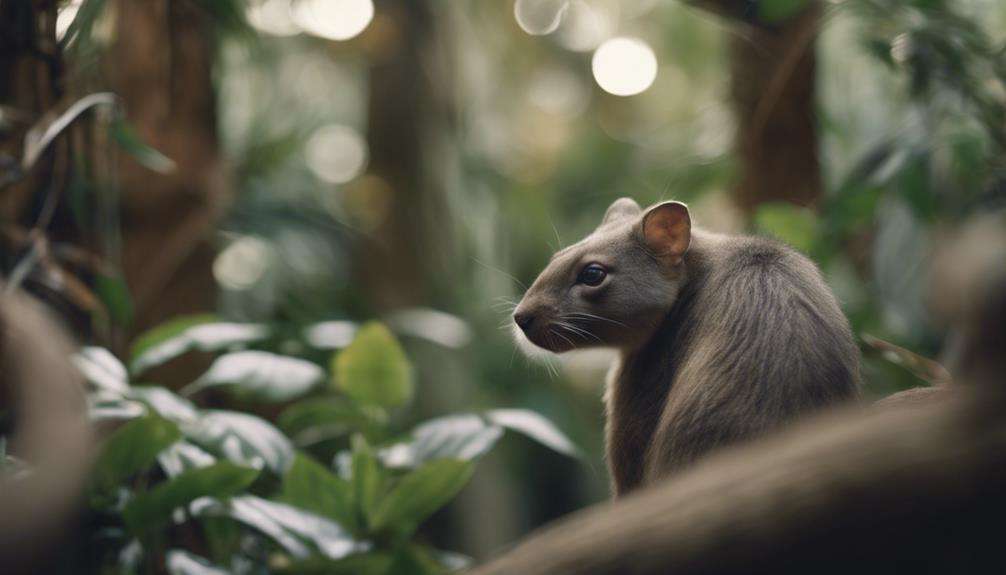
When designing the habitat for exotic mammals, you should prioritize providing adequate hiding spots and cozy shelters to promote a sense of security and reduce stress.
Ensuring the enclosure is escape-proof and free of potential hazards is crucial for creating a safe environment for these animals.
Additionally, using bedding materials that mimic their natural habitat can enhance comfort and security, contributing to their overall well-being.
Habitat Design Basics
To create a safe and secure environment for exotic mammals, ensure that their habitat includes hiding spots and elevated areas for security and comfort, uses non-toxic and durable materials for construction, and provides adequate ventilation and lighting mimicking their natural surroundings.
Habitat Design Basics:
- Hiding Spots: Incorporate cozy nooks and dens for your exotic mammal to retreat to when feeling stressed or anxious.
- Elevated Areas: Install platforms or shelves to give your pet a vantage point, promoting a sense of security and territorial control.
- Proper Lighting: Mimic natural day-night cycles with adjustable lighting to maintain your exotic mammal's circadian rhythm and overall well-being.
Enrichment for Stimulation
In creating a stimulating environment for your exotic mammal, consider incorporating various enrichment activities that cater to their natural behaviors and instincts. Enrichment like foraging puzzles and climbing structures can engage your exotic mammal's instincts, providing mental stimulation.
Offering hiding spots and tunnels in their habitat not only promotes exploration but also gives them a sense of security. Introducing novel scents, textures, and sounds can enrich their sensory experiences, keeping them engaged and curious.
Rotating toys and enrichment items regularly can prevent boredom, encouraging continuous mental stimulation. By creating a varied and dynamic environment that mirrors the complexity of their natural habitats, you can significantly enhance the well-being of your exotic mammal.
Safety Measures Implementation
Building upon the foundation of creating a stimulating environment for your exotic mammal, ensuring their safety and security is paramount in fostering their overall well-being and contentment. When implementing safety measures for your exotic mammals, consider the following:
- Regularly inspect enclosures for any gaps or weak spots that could lead to potential escapes.
- Remove any toxic plants, chemicals, or small items that may pose a hazard to your exotic mammals.
- Use secure locks and latches on enclosures to prevent accidental escapes and ensure a safe environment for your exotic pets.
Incorporating Positive Reinforcement Techniques
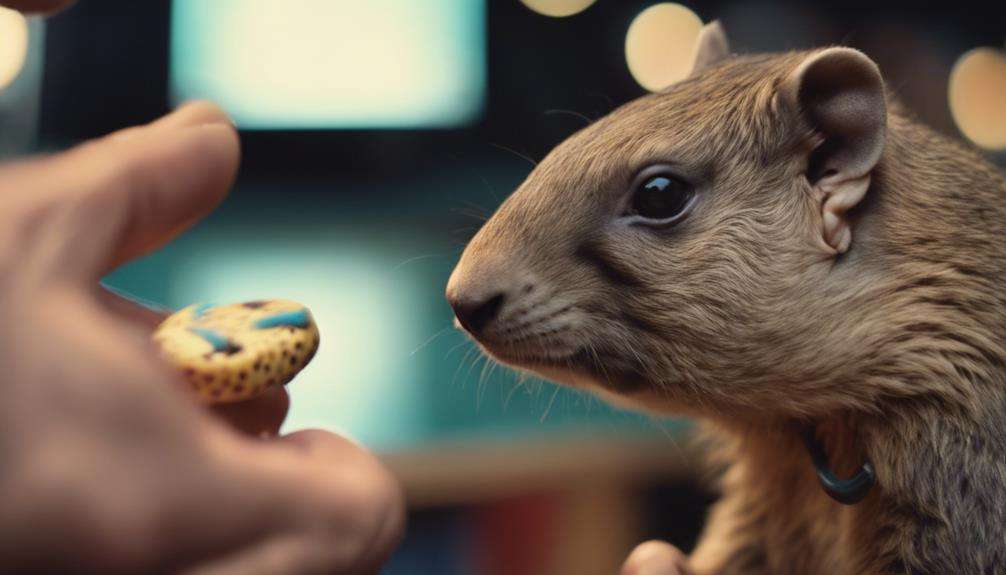
When implementing positive reinforcement techniques with exotic mammals, tailoring rewards to match their individual preferences is key to fostering a strong bond. Positive reinforcement involves rewarding good behavior with treats, praise, or playtime to encourage bonding. By using specific cues and rewards, exotic mammals learn to associate positive outcomes with their actions, reinforcing the bond with their owners. Consistency in applying these techniques can lead to lasting behavioral changes and a deeper connection between exotic mammals and their human companions.
It is crucial to understand that each exotic mammal has unique likes and dislikes, so tailoring rewards to suit their preferences enhances the effectiveness of positive reinforcement. This tailored approach ensures that the rewards are truly motivating for the individual animal, increasing the success of the bonding process. Positive reinforcement techniques have been proven to be highly successful in building trust, confidence, and a strong relationship with exotic mammals. By incorporating these methods into your interactions, you can create a positive and enriching bond with your exotic mammal.
Building Mutual Trust and Respect
To establish a strong foundation of trust and respect with exotic mammals, spending quality time near their habitat is essential to familiarize them with your presence. As you engage with these exotic pets, remember that building trust is a gradual process that requires patience and understanding.
Here are key tips for nurturing mutual trust and respect:
- Positive Reinforcement: Utilize treats and positive reinforcement techniques during interactions to create a positive association and encourage desired behaviors. This approach not only fosters a sense of reward but also strengthens the bond between you and the exotic mammal.
- Building Trust: Handle the exotic mammal gently and respectfully, respecting their boundaries and preferences. By showing care and consideration, you demonstrate that you're a reliable and trustworthy presence in their environment.
- Interactive Engagement: Engage in interactive activities that cater to the exotic mammal's interests, allowing for meaningful and enjoyable interactions. This interactive approach promotes a sense of connection and understanding, further solidifying the bond between you and the exotic pet.
Establishing a Consistent Routine
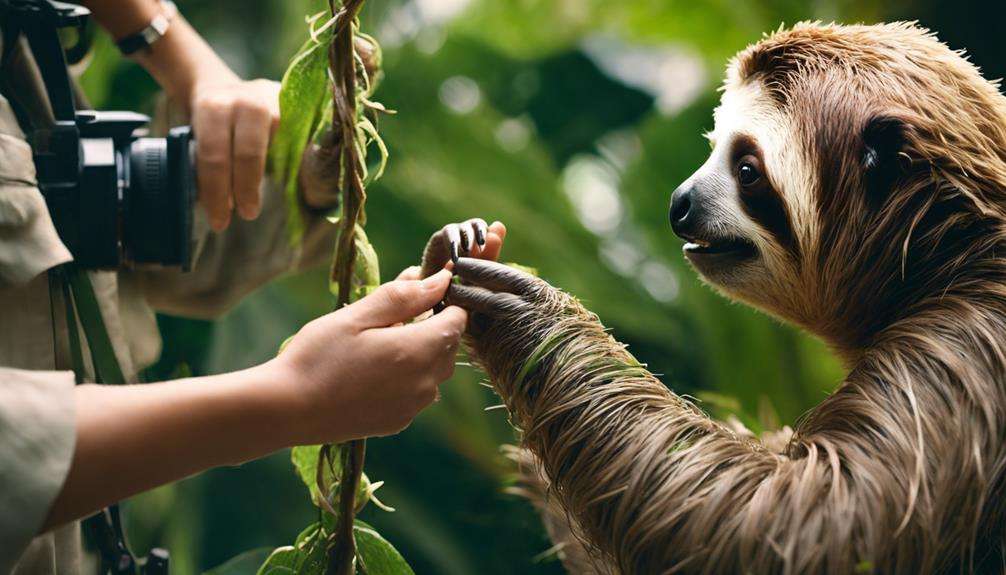
Establishing a consistent routine for exotic mammals is crucial for providing them with stability and predictability, ultimately promoting their well-being and strengthening the bond between you and your exotic pet. By implementing a regular schedule for feeding, playtime, and interaction, you're creating a sense of security and comfort for your exotic mammal. This routine not only helps reduce stress and anxiety but also aids in training and behavior modification. Consistency in daily activities such as exercise and enrichment plays a vital role in maintaining the physical and mental well-being of your exotic pet.
Through a structured routine, you aren't only fostering trust and familiarity but also enhancing the bond between you and your exotic mammal. The predictability of a routine allows your pet to anticipate interactions and activities, building a sense of security and strengthening your relationship. By engaging in daily activities together at set times, you're creating a foundation for a strong and lasting bond based on trust and shared experiences.
Nurturing Physical and Mental Well-being
Nurturing the physical and mental well-being of exotic mammals involves providing enriching activities and regular exercise to promote their overall health and prevent boredom. To achieve this, consider the following:
- Enriching Activities: Incorporate obstacle courses and foraging toys to enhance mental stimulation and keep exotic mammals engaged and mentally active.
- Physical Health: Implement regular exercise and playtime sessions to maintain the physical health of exotic mammals, preventing issues related to inactivity.
- Safe Environment: Create a secure space with varied textures and materials for exploration, allowing exotic mammals to engage their senses and ensuring they feel safe while engaging in natural behaviors.
In addition to these activities, utilizing positive reinforcement training techniques during bonding activities can strengthen the relationship and trust between you and the exotic mammals. By providing a stimulating environment, promoting physical well-being, and ensuring safety, you can contribute to the overall positive mental state of these unique creatures.
Exploring Unique Bonding Rituals
Exotic mammals exhibit a variety of unique bonding rituals that play a significant role in fostering connections and trust between them and their caregivers.
For instance, sugar gliders, known for their strong social bonds, engage in scent marking and grooming rituals to strengthen their relationships with each other and their human companions.
Slow lorises, on the other hand, bond through gentle handling and mimicking their natural behaviors, such as slow movements and soft vocalizations, which helps them feel secure and comfortable.
Fennec foxes form strong bonds by participating in play activities like digging and exploring together, creating shared experiences that deepen their connection.
Wallabies build trust through close physical contact and grooming sessions, reinforcing their social bonds and promoting a sense of closeness.
Similarly, kinkajous establish bonds through shared meal times and interactive feeding experiences, where they learn to associate positive interactions with their caregivers, further solidifying their relationship.
These unique bonding techniques are essential for nurturing healthy and lasting connections with these exotic mammals.
Seeking Professional Guidance When Needed
When faced with complex bonding challenges with your exotic mammal, seeking professional guidance is crucial. Expert consultation can provide valuable insights into your pet's behavior and needs, helping you navigate any obstacles in the bonding process.
Consulting with veterinarians and behaviorists who specialize in exotic species ensures that you receive the necessary guidance to foster a strong and healthy bond with your unique companion.
Expert Consultation Benefits
By consulting with experts in exotic mammal care, you gain access to specialized knowledge and tailored advice to ensure the well-being and bond with your unique mammalian companion. These professionals can provide personalized care plans and effective communication strategies, enhancing the relationship with your exotic pet. Here are three emotional benefits of seeking expert guidance:
- Peace of Mind: Knowing that your exotic mammal is receiving the best care possible can alleviate stress and allow you to enjoy your bond.
- Confidence: Learning from experts can boost your confidence in handling your exotic mammal's needs, strengthening your connection with them.
- Security: Having a support system of knowledgeable professionals can make you feel secure in your exotic mammal care journey.
Professional Input Importance
Seeking guidance from professionals in exotic mammal care can provide invaluable insights and expertise to enhance your bond with these unique companions. Professional input is crucial in understanding the intricacies of behavior training for exotic pets. With their specialized knowledge, experts can introduce effective techniques like positive reinforcement to shape desired behaviors.
Additionally, professional guidance ensures that you approach handling and care for exotic mammals in a way that prioritizes their well-being. By consulting with professionals, you can address specific behavioral issues and develop tailored training plans that cater to the individual needs of your exotic pet. This interaction not only fosters a stronger bond but also enriches the overall experience of caring for these fascinating animals.
Guidance for Exotics
Turning to professionals for guidance on caring for exotic mammals is a crucial step in ensuring their well-being and fostering a strong bond between you and your unique companions.
When seeking assistance for your exotic pets, consider the following:
- Tailored Pet Training: Exotic mammal specialists can offer personalized training strategies to address specific behaviors and enhance the bond between you and your pet.
- Building a Bond Through Positive Reinforcement: Professional guidance can help you understand the importance of positive reinforcement techniques in strengthening the relationship with your exotic pet.
- Ensuring Welfare and Health Care: Experts can provide crucial advice on diet, enrichment, and health care, ensuring the overall well-being of your exotic mammals under your care.
Frequently Asked Questions
What Is the Rarest Exotic Pet?
The Fennec fox stands out as one of the rarest exotic pets, captivating owners with its unique behaviors and forming unusual companionships. Embrace the challenges of exotic pet ownership and enjoy the rewards.
What Exotic Animals Are Cuddly?
Ever wondered about exotic animals that are cuddly? Unusual pairings like sugar gliders, chinchillas, and ferrets make surprising snugglers. These adorable oddballs, including hedgehogs and guinea pigs, can show uncommon affection with proper bonding techniques.
What Is the Coolest Exotic Pet?
For the coolest exotic pets, consider those with unique behaviors like sugar gliders' gliding abilities, fennec foxes' large ears, and hedgehogs' spiky appearance. These fascinating creatures thrive in their natural habitats, making them popular breeds among exotic pet enthusiasts.
What Special Care Do Exotic Animals Need?
In caring for exotic animals, remember enrichment activities for mental health, special diets for nutrition, unique habitats for comfort, and social interactions for companionship. Understanding their needs ensures a happy, healthy bond.
Conclusion
As the sun sets on another day spent bonding with your exotic mammal, you reflect on the moments shared in the enriched environment you've carefully crafted.
The playful interactions, the trust formed through positive reinforcement, and the unique rituals you've embraced all contribute to a deeper connection with your special companion.
With each passing day, your relationship blossoms like a rare flower, vibrant and full of life. Keep nurturing this bond, and watch it continue to grow and flourish.
